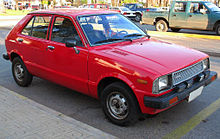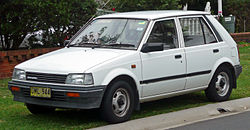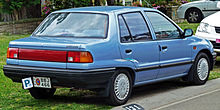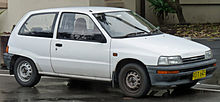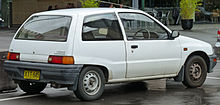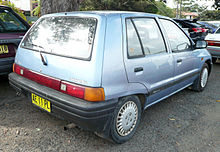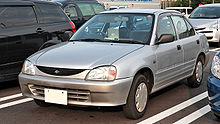- Daihatsu Charade
-
Daihatsu Charade 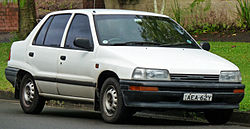
Manufacturer Daihatsu Also called Tianjin Xiali (1992–current, CN) Production 1977–present Predecessor Daihatsu Consorte Successor Daihatsu Storia Class Supermini The Daihatsu Charade is a supermini which was first introduced in 1977. Daihatsu considers the Charade a "large compact" car to differentiate it from smaller compacts in its lineup, such as the Daihatsu Mira/Cuore. It helped replace the Daihatsu Consorte, although the Charmant took over from the bigger-engined Consortes.
In China, Daihatsu Charade is called "Xiali" and made by FAW Tianjin, under the registered mark of "China FAW". From 1986 September 30, to 2009, it sold over 1.5 million in that country.
Contents
First generation (G10/G20; 1977–1983)
First generation 
Manufacturer Daihatsu Production 1977–1983 Predecessor Daihatsu Consorte Body style 3/5-door hatchback Layout FF layout Engine 843 cc CD I3
993 cc CB I3Transmission 5-speed manual Wheelbase 2,300 mm (90.6 in) Length 3,460–3,530 mm (136.2–139.0 in) Width 1,520 mm (59.8 in) Height 1,360 mm (53.5 in) The first generation (G10) appeared in October 1977. It was a front-engined front-wheel drive car, available as a three- or five-door hatchback, powered by a 993 cc 3-cylinder engine (CB20) with 50 PS (37 kW). Japanese market cars claimed 55 PS (40 kW) JIS at 5,500 rpm.[1] The three-door version ("Runabout") received two little round "opera windows" in the C-pillars. This car was a surprise success in Japan, where ever tighter emissions standards had made many observers consider the 1 liter car dead in the marketplace. The Charade became an overnight success and also became the Japanese Car of the Year.[2]
The early G10 (Series 1) had round headlights and the late G10 (Series 2) had square headlights. The Series 2 was introduced for 1981. Between the introduction in 1977 and December 1982, Daihatsu built 89,792 G10/G20 type Charades.[3]
The Daihatsu Charade was very popular in Chile and some other Latin American countries during the 1970s and 1980s. Originally the same as in the rest of the world, later Chilean Charades (called G20) came equipped with a downsleeved 843 cc version (CD) of Daihatsu's three-cylinder engine. This engine produced 41 PS (30 kW) at 5,500 rpm and has also appeared in export versions of the Daihatsu Hijet.[4] The G20 was also able to run on low-octane fuel or even Ethanol.[5] The first G20 version (1978–1981) had round headlights, while the second generation G20 (sold from 1981 to 1984) received the same facelift as did the G10, meaning square headlights and slightly different rear lights. The three-door "Runabout" retained the larger 1,000 cc CB20 engine, and also received a five-speed transmission and tachometer.
Second generation (G11; 1983–1987)
The second generation (G11) was released in 1983, again as a 3- or 5-door hatchback. It featured several variations of the 3-cylinder 1.0 L engine, including a turbocharged version with 68 PS JIS and diesel and turbo-diesel versions. A five-speed manual transmission was available. The base Charades received the naturally aspirated, three cylinder, 993 cc CB23 engine with around 50-55 PS. 0-60 mph takes around 12–13 seconds. The other Charade Turbo and Charade DeTomaso models had the upgraded CB23 engine, called the CB60. The CB60 was also a 993 cc engine, but was fitted with a very small IHI turbocharger, which increased its power to 68 PS (50 kW). The tiny turbocharger meant that an intercooler was not necessary. The suspension was lightly upgraded, with thicker anti-roll bars and slightly stiffer suspension, and the car also received alloy wheels rather than the standard steel items.[6]
There were also high roofed versions available in some markets, either with three or five-door bodywork. The Japanese market "Van" version also received the higher roof. In Chile (and some other Latin American countries) this generation was called the G21, and like the G20 before it, it was equipped with the smaller CD-series 41 PS (30 kW) 843 cc three-cylinder engine.[7] The G21 was sold between 1986 and 1990 approximately.
The G11 was produced with two frontends, with square headlights (Series 1) and rectangular "cat's eye" shaped headlights (Series 2). In Europe, the G11 underbody and various engines and transmissions also formed the basis for the Innocenti Minitre after Innocenti's contract with British Leyland expired. The G11 underpinnings continued to be used by the Italian automaker until 1992.
Daihatsu Charade model codes code engine note G11 CB, 993 cc passenger car petrol G11V commercial G21[a] CD, 843 cc passenger car G26 CE, 926 cc 926R G30 CB, 993 cc passenger car diesel G30V commercial a Latin America only In 1985, at the Tokyo show, Daihatsu introduced the 926R, a prototype of a mid engine Charade, developed together with DeTomaso and designed to take part in the World Rally Championship for cars under 1,300 cc. The 926R had a mid-mounted 926 cc twelve valve, twin-cam, turbocharged three-cylinder engine ("CE") - moving the rear wheels through a five-speed manual transmission and delivering 120 PS (88 kW). The 926R weighed 800 kg and had wider fenders to cover the 205/225 15" wheels. However, following significant crashes in the 1985 Championship, Group B was banned and the 926R project was called off.
Third generation (G100; 1987–1994)
The third generation of the Daihatsu Charade (G100) debuted in 1987. With styling by Daihatsu chief stylist Hiroshi Aoki and colleague Hideyuki Ueda,[8] it originally shipped with a carburetted 1.0 L three-cylinder engine (CB23), also available as a diesel and turbodiesel, or with a 1.3 L four-cylinder with single carburetor (HC-C). Either three-door or five-door hatchback bodystyles were originally offered. A 1.0 L twin-cam fuel injected intercooled turbo (CB70/CB80), named GTti and delivering 105 PS JIS (77 kW) was later added, only available as a three-door hatch. Fuel injected versions of the 1.3 L four-cylinder (HC-E) and three-cylinder (CB90) were later added. A four-door sedan was released with the 1.3 L EFI engine in 1988. There were two different sport models available (both with G100S-FMVZ modelcodes), the GTti and the GTxx. Both versions are mechanically identical, but the GTxx features many added luxury items. These included full bodykit, lightweight 14" speedline alloys, Air-con, power steering, one-touch electric window down, electric sunroof. Some of these options were also available to buy as optional extras on the GTti, Side-skirts were also fitted to many GTti's, but in some countries they were ony sold as a dealer optional extra.
The GTxx is much rarer than the GTti, mainly being sold in Japan only, although some were imported and sold in other countries in small numbers. All GTxx's have engine code CB70, whereas GTti's can have CB70 or CB80, depending on the country/region sold. There are no known differences with the actual engine internals, all CB70s featuring catalyst emissions control system. Even some CB80's for Europe also featured the catalyst, although UK cars did not. There are more than likely slight differences between the CB70 and CB80 ECU mapping, with CB70 cars quoted as producing 105 PS vs the CB80's 100 PS (74 kW). This is probably down to the CB70 having the ignition timing mapped more advanced to suit the higher octane fuel used in Japan.
A slight facelift in 1991 gave the cars smoother style rear lights/reflector panel, a slightly longer tailgate top spoiler, and a revised interior trim with fabric also on the door cards. There was also a four-wheel drive version of the fuel injected 1.3 (90 PS/66 kW HC-E engine, G112 chassis code) sold at home and also exported to a few countries for example in Scandinavia.
In the UK, the GTti had a fairly successful rally career competing in the RAC Lombard Rally in 1989 and 1990 and was highly competitive in the Safari Rally. The GTti won class honours many times and was able to mix it with some of the 2-litre cars and on occasion troubling some of the 4wd cars!
The third-generation car was sold in the United States for just four years, from 1988 through 1992. The car sold poorly, despite construction "as tight as a frozen head bolt"[8] and attractive styling for the market segment,[9] perhaps because of its high price, few dealerships, rough running three-cylinder,[8] low performance (0-60 mph/97 km/h in 15 seconds),[8] and unfortunate translation of the name Charade into English, and the company withdrew permanently from the US market. Sales for 1989 were 15,118. Only the three-door hatchbacks and four-door sedans were available. The North American Charade appeared in three different trim levels until 1989; the CES (Base model), CLS, and CLX. The CES came with a 53 bhp, 1.0L three-cylinder, EFi engine called the CB-90. The other two variants were available with the standard CB-90 or the more powerful 1.3 L four-cylinder EFi "HC-E" engine. In 1990, the trim levels were reduced to just two, the SE (base) and more luxurious SX. All models were available with a five-speed manual gearbox or an automatic transmission.
In the Australian market, the GTti was unavailable and the turbocharged petrol Charade used the lower powered carburetor engine (CB60/61) from the previous generation.[6] However, quite a few GTti's & GTxx's have been imported from Japan and so do have a good following.
The G100 Charade has been built by FAW Tianjin as the Tianjin Xiali since 1988, replacing brief CKD production of the previous generation model there. Heavily facelifted versions with more modern Toyota engines are still available, as well as copied versions like the Huali and various Geely products such as the Haoqing and its derivatives.
Fourth generation (G200, G203; 1993–2000)
The fourth generation was introduced in 1993, again with hatchback and sedan bodies. A 1.0 L engine was the base model in Japan, but in many European countries, the SOHC 1.3 L was used. The sedan, introduced in 1994, featured a 1.5 L engine with optional 4WD. The Diesel models were dropped in all markets where they were previously available.
The turbocharged GTti version was replaced by a more conventional GTi with an SOHC 16-valve 1.6 L engine. This version was engineered by Italian ex-racing driver De Tomaso (the previous owner of Innocenti), including racing-derived camshaft, and was capable of 124 hp JIS (91 kW) in the Japanese market. The export version was detuned to 105 hp DIN (77 kW). De Tomaso also added their own bodykit, Recaro seats, a Nardi Torino steering wheel, and Pirelli sports tyres. A total of 120,000 Charade GTi were produced following this joint effort.
The Charade was restyled in 1996, only two years after release (with the codename G203). It had a ‘smiley face’ grille and changed headlights, looking more like its Toyota sibling the Starlet. It was produced until 2000, when it was replaced by the Sirion/Storia.
Nameplate return
In 2003, the Charade name was resurrected in the UK and Australia. The new Charade is now a rebadged Daihatsu Mira (Cuore in other European markets, Charade in Morocco[10]), and it is positioned one market segment below its previous generations. It is available as a 3- or 5-door hatchback with a 1.0 L engine. It has since been discontinued in Australia due to Toyota retiring the Daihatsu nameplate in Australia, due to the market climate and the fact that Toyota believes that the Toyota Yaris suffices as their smallest car in Australia. In 2011, Daihatsu Europe brought the Toyota Yaris on the market as Daihatsu Charade. This is be the last new model introduced under the Daihatsu nameplate in Europe.
Safety
In Australia, the Daihatsu Charade was assessed in the Used Car Safety Ratings 2006 as providing "significantly worse than average" protection for its occupants in the event of a crash.[11][dead link]
References
- ^ (in Japanese) Car Graphic: Car Archives Vol. 5, '70s Japanese Cars. Tokyo: Nigensha. 2007. p. 137. ISBN 978-4-544-09175-5.
- ^ Yamaguchi, Jack K. (1979), Lösch, Annamaria, ed., "The Year of Uncertainty?", World Cars 1979 (Pelham, NY: The Automobile Club of Italy/Herald Books): 62, ISBN 0-910714-11-8
- ^ Adam, Rainer. "Facts". Charade-G10.net. http://www.charade-g10.net/data.htm. Retrieved 2011-05-22.
- ^ Varela Romero, Wenceslao (1987) (in Spanish), Manual de Automoviles: Daihatsu, Suzuki y Utilitarios [Car Manual: Daihatsu, Suzuki, and Minitrucks], Santiago, Chile: Ediciones Mar del Plata, p. 14
- ^ Adam, Rainer. "Daihatsu Charade G20". Charade-G10.net. http://www.charade-g10.net/g20.htm. Retrieved 2011-05-22.
- ^ a b Knowling, Michael (2001-09-18). "Daihatsu Charade Turbo". AutoSpeed (Web Publications Pty Ltd) (18). http://autospeed.com.au/cms/article.html?popularArticle&A=1126.
- ^ W. Varela R., p. 7
- ^ a b c d "Road Test: Daihatsu Charade", in Car and Driver, 1/88, p.116.
- ^ "Road Test: Daihatsu Charade", in Car and Driver, 1/88, pp.116-7.
- ^ [1][dead link]
- ^ [2][dead link]
External links
Current vehicles: Atrai/Hijet · Be-go/Terios · Boon/Sirion · Coo/Materia · Copen · Mira/Cuore/Charade · Mira Cocoa · Move · Tanto · Tanto Exe · XeniaPast vehicles: Altis · Applause · Bee · Ceria · Charade · Charmant · Compagno · Cuore · Consorte · Domino · Esse · Leeza/Leeza Spyder · Fellow Max · Max · Midget · Mira Gino/Trevis · Naked · Opti · Gran Move/Pyzar · Rocky/Feroza/Sportrak · Rugger/Rocky/Fourtrak · Sirion/Storia · Sonica · Taft/Scat · Taruna · Valera · YRVConcept Cars: ai · Basket · Copen (1999) · Costa · D-Bone · D-Compact X-Over · Deca Deca · Extol · EZ-U · FFC · HVS · Micros-3R · OFC-1 · SK-Tourer · SP-4 · U4B · UFE2 · UFE-III · X-021 · Mudmaster CRace Cars: P3 · P5- http://devoteesofcharade.com - For Malaysian Charade fans
Categories:- Daihatsu vehicles
- Hatchbacks
- Vehicles introduced in 1977
Wikimedia Foundation. 2010.

